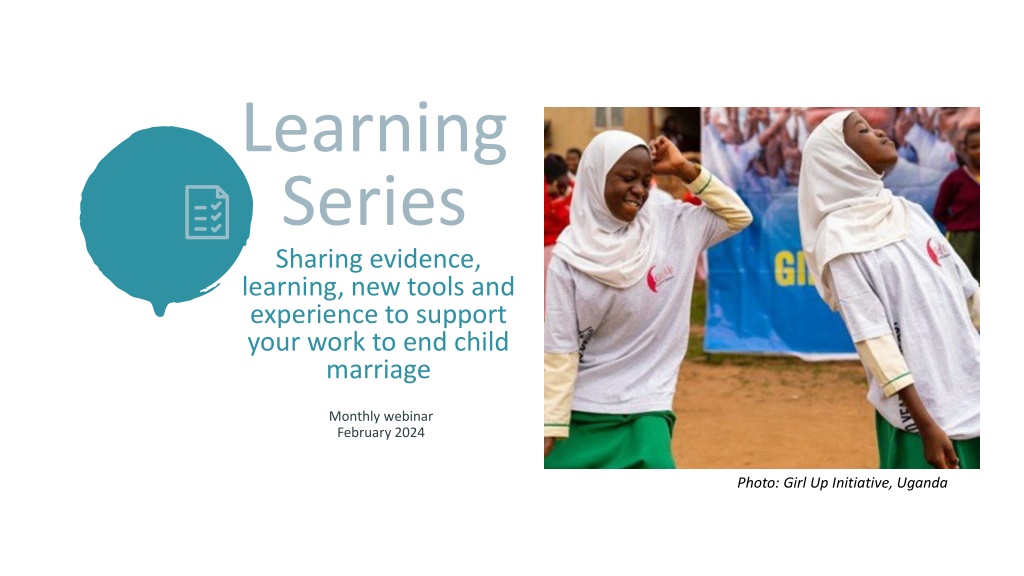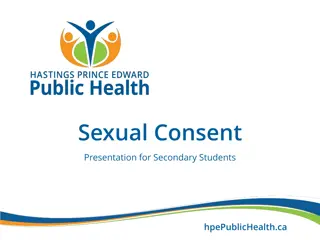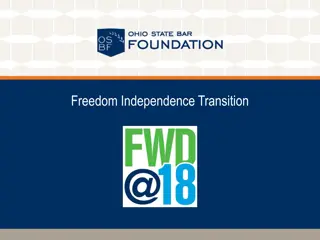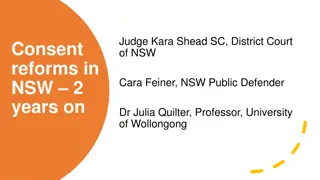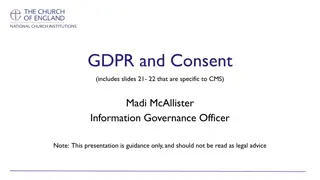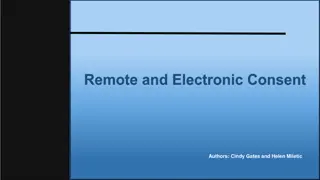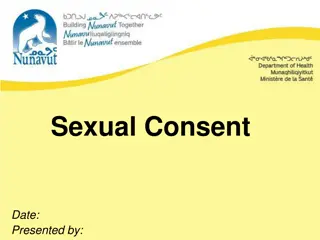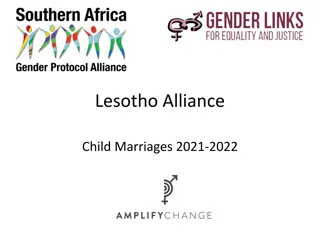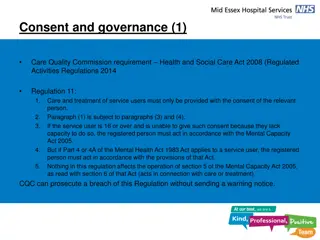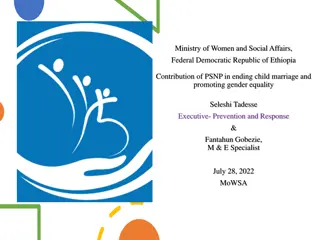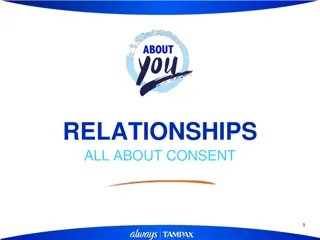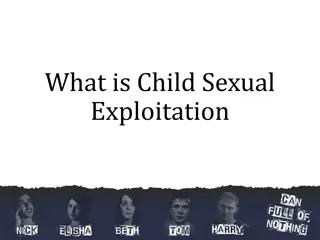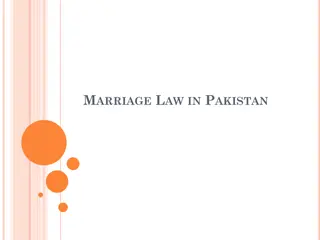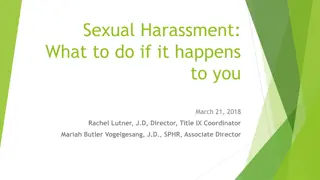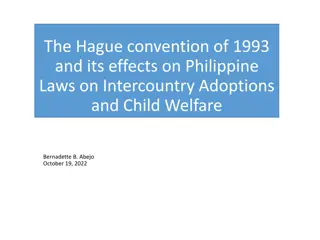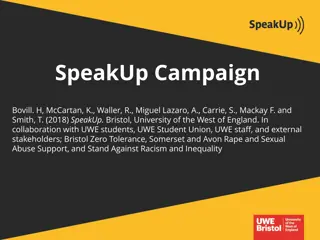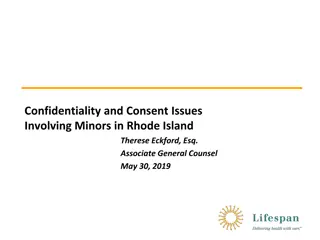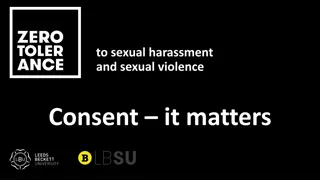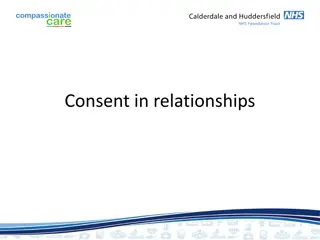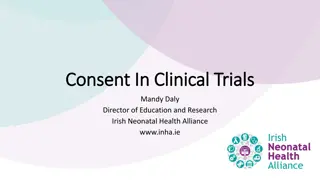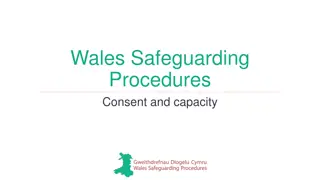Understanding the Impact of Age of Marriage and Sexual Consent Laws on Ending Child Marriage
Explore the influence of age of marriage and sexual consent laws on child marriage and girls' rights in a learning series session. Discover global evidence, implications for national-level work, and key factors affecting the prevalence of early marriage. Gain insights into countries with varying minimum age of marriage laws and factors that either hinder or support efforts to delay marriage.
Download Presentation

Please find below an Image/Link to download the presentation.
The content on the website is provided AS IS for your information and personal use only. It may not be sold, licensed, or shared on other websites without obtaining consent from the author. Download presentation by click this link. If you encounter any issues during the download, it is possible that the publisher has removed the file from their server.
E N D
Presentation Transcript
Learning Series Sharing evidence, learning, new tools and experience to support your work to end child marriage SIX SHARED GOALS Monthly webinar February 2024 Photo: Girl Up Initiative, Uganda
Interpretation ENGLISH - This session will have presentations in English. To access simultaneous interpretation, please click on the globe icon at the bottom bar of your screen and select your preferred language (English, Spanish, French, or no interpretation). FRAN AIS - Cette session comprendra des pr sentations en anglais. Pour acc der aux services d'interpr tation simultan e, veuillez cliquer sur l'ic ne globe que vous trouverez dans la barre inf rieure de votre cran, et s lectionnez la langue de pr f rence (anglais, espagnol, fran ais, ou version originale). ESPA OL - Esta sesi n tendr presentaciones en ingl s. Para acceder a los servicios de interpretaci n simult nea, por favor haga clic en el icono del globo que encontrar en la barra inferior de su pantalla, y seleccione su idioma de preferencia (ingl s, espa ol, franc s, o versi n original).
THE IMPACT OF AGE OF MARRIAGE AND SEXUAL CONSENT LAWS ON CHILD MARRIAGE AND GIRLS RIGHTS LEARNING SERIES SESSION FEBRUARY 2024
AGENDA Introduction to the topic Presentation of global evidence Implications for national level work 2024 plans
Countries with minimum age of marriage laws 153 of 198 countries have minimum age of marriage 18 laws. 2019 52% countries have 18 no exceptions marriage laws. 38 countries had different minimum age of marriage under the law for women and men. 6 countries did not specify any minimum age at all.
What helps and what hinders to tip the scales in favour of delayed marriage? Minimum age of marriage laws Discriminatory norms that hold the practice of child marriage in place and act as roadblocks to laws Growing support for girls education Growing awareness of the harms of unwanted earlypregnancy Normative counterpoints: exceptions and pluralistic legal systems. Positive normative environment that rejects the practice of child marriage (declarations, resolutions) Systems and structures that systematically uphold male privilege and other inequalities and reinforce discriminatory norms. Changing hearts and minds by supporting behaviour change among individuals, in communities and society. Adapted from Greene, M. and Stiefvater, E (2019)
Snapshot of changes to marriage laws around the world Mexico - threatenedcriminalisation of forced cohabitations /unions Tanzania no change despite the 2016 and then 2019 Supreme Court of Appeal ruling in favour of raising the AOM to 18 England and Wales legal age of marriage increases from 16 to 18 Morocco proposed reform of the 2004 Family Code to remove judicial dispensation to families to marry girls under legal age of 18. Spain in 2022 passed changes to sexual consent law emphasising the need for affirmative consent Source: GNB Youth Activism Training Manual (2018)
RECENT EVIDENCE ON THE IMPACT AND IMPLICATIONS OF CHILD MARRIAGE LAW A GLOBAL SYNTHESIS FEBRUARY 2024
AGENDA Research questions Human rights framework Primary findings Ways forward Six things to remember
Research questions What are the impacts of child marriage and sexual consent laws on: Child marriage prevalence Girls rights & agency To what extent are laws centring the rights and agency of girls, in all their diversity? o What are the barriers to this?
The available literature Child marriage law impact literature Focus on correlation, not causality Need more socio-legal research 1 2 Child marriage law literature National vs international law 3 Child marriage literature Interventions that: Reduce prevalence Support girls rights
History of the minimum age of marriage 1965 a UN General Assembly resolution calls for 15 years to be the lowest age for marriage 1994 the CEDAW Committee specifies 18 years as the minimum age of marriage 2004 Committee on the Rights of Child reiterates 18 years as the minimum age of marriage
Interpretations of the Committee on the Rights of the Child on sexual consent Set an age of sexual consent Avoid criminalising consensual sex Recognise evolving capacities Presume competence to seek services
It is hard to isolate the effect of the law and establish a causal link with child marriage prevalence There is limited evidence Most studies cannot isolate the impact of the law from other factors (with exceptions) Most studies do not measure the before and after effect of a new law or reform OR analyse how a law is implemented
Laws have had a limited impact on child marriage prevalence but have raised the age of marriage in some contexts In 60 countries there was no drop-off in the number of girls marrying just below the age of marriage In 5 countries age at marriage laws had limited or no impact In Ethiopia where the average age of marriage was below 18 before the legal reform: The probability of marriage under age 16 decreased post-reform The probability of marriage at age 16 or 17 increased post-reform
Context and identity factors heavily influence the impact of the law and the dynamics of marriage/union The implementation and impact of the law is affected by: Experience of crisis Rurality Ethnicity In India & Nepal laws have contributed to a rise in self-initiated marriages due to stigma and criminalisation around young people s sexuality In Mexico the national ban on marriage under age 18 led to a decrease in formal marriages and a similar increase in informal unions In Latin America and the Caribbean laws have not considered contextual drivers of marriage and union
[T]here is a long way to go before child marriage is eradicated, and changes in legal provisions are playing only a minimal role, if any. This pushes scholars and policymakers to think about alternative policies that might be more effective in curbing early marriage or delaying age at first union. Batyra & Pesando, 2021 (emphasis added)
The law does not match adolescents realities and their evolving capacities are rarely considered Adolescence is a relatively new legal category Criminalising adolescent sexuality and/or raising the age of sexual consent does not reflect reality Judges can apply evolving capacities in their interpretations of individual cases But reform driven by judicial interpretation rather than lawmakers can lead to slow implementation and uptake
Criminalising adolescent sexuality blocks their access to sexual and reproductive health information and services Laws interacted with norms in 8 countries to restrict adolescents' access to SRHR information and services In some countries, there are contradictions between the age of sexual consent and the right to access SRH services in health policy Providers refuse to offer SRHservices to adolescents for fear of legal repercussions
...many children and young people who are not legally recognised as able to consent to sex are in fact sexually active, and in need of sexual and reproductive health services. This dilemma has given rise to a hodgepodge of confused legal, policy and programmatic measures which place various age-based limitations on children s decision-making Yarrow et al, 2014 (emphasis added)
The law is weaponised against girls but also not available for those who need access to justice In El Salvador communities believe sexual consent laws are intended to prevent young people from being sexually active In India and Nepal parents are using the law to break up marriages they disapprove of, including where they are inter-caste In India the law is rarely used to support girls who have experienced forced marriage
The use of punitive approaches has a range of consequences in girls lives In Ethiopia, Malawi and Egypt punitive legal approaches drive child marriage underground, where girls cannot access services, social support or justice In Mexico the criminal law could exacerbate existing marginalisations due to greater penalties when cases involve people of Indigenous or Afro- Mexican descent Girls can face harassment or emotional abuse by law enforcement officials when they make a complaint, or social stigma from communities Legal enforcementoften replaces efforts to enhance the welfare of girls and young women, and their communities
Girls and their allies face barriers to justice Lack of anonymity in reporting cases of child marriage to the police Uncertainty due to conflicting laws or discrepancies between formal and informal law State birth and marriage registration systems are often under-resourced and staff are unprepared Lack of awareness in communities about laws and policies Girls cannotaccess legal systems without a legal adult Financial barriers due to cost of legal representation
Embed legal advocacy in a comprehensive, gender- transformative approach to gender equality 1
Contextualise, contextualise, contextualise 2 What does this look like? More research to understand the specificities of how laws impact the whole population, and girls in all their diversity Legal advocacy informed by deep understandings of evolving capacities in each context Understanding how (criminal) laws shape and respond to the prevalence of different types of marriage and unions
3 Address barriers to girls access to justice What does this look like? Legal literacy campaigns for girls and their communities to increase awareness of the law and the rights and protections it offers for girls Working with girls to understand their needs and advocating with them for changes to address them Ensuring support services and legal aid are available to girls who have been forced into marriage
Six things to remember Laws seem to have very limited impact on prevalence 1 Criminalisation & punitive approaches can have negative consequences 2 Girls facing forced marriage and ever-married girls face barriers to accessing justice 3 Age of marriage & age of sexual consent should not be combined in law 4 The principle of evolving capacities is key Laws are one, if important, part of context-specific, gender-transformative approaches to girls rights 5 6
Thank you GirlsNotBrides 0044 (0)20 1234 5678 GirlsNotBrides
WHAT THIS MEANS FOR ADVOCACY AND PRACTICE A COUNTRY PERSPECTIVE OF THE IMPLICATIONS OF THIS EVIDENCE FROM NEPAL AND MALAWI
Irada Gautam Panchapuri Municipality, western Surkhet, Nepal
1. Child marriage in Nepal Child marriage prevalence in Nepal is 33% 20 is the legal minimum age for marriage and informal union for women and men. Marriage under the age of 20 with or without consent - is illegal, void, with no exceptions with fines and / or imprisonment Self-initiated marriages are on the rise. Age of marriage has increased from 14/15 to 16-18. Where any person has sexual intercourse with a woman without her consent or with a girl child below 18 years of age even with her consent, the person shall be considered to commit rape on such woman or girl child. National Penal Code, 2017.
2. AAWAAJ: justice and empowerment Breaking the silence on sexual abuse and exploitation through social mobilization; Child protection, child helpline and child friendly spaces; Community support mechanism against gender- based violence; Temporary shelter support centre and social integration for women and children; Community and family mediation; Counselling, care and support; Lobbying, advocacy and campaigning against gender-based violence, child sexual abuse, exploitation and trafficking; Strengthening local governance and community development; Key aspects for good practices in the prevention of Violence, Abuse, Exploitation & Trafficking (AAWAAJ)
3. AAWAAJ experience with child marriage law AAWAAJ experience: The evidence from Nepal says: Unsuccessful elopements put girls in situations of even greater vulnerability in Nepal. Child marriage and sexual consent laws have contributed to a rise in self-initiated marriages among adolescents below the legal minimum age. Selective use of child marriage law (inter- caste). Ample evidence of parents using the law to break up marriages they disapprove of, including where they are inter-caste Under-reporting: stigma & shame; lack of anonymity; economic dependency. Having the age of marriage set at 20 and the legal age of majority as 18 creates confusion for advocates and young people. Many do not register births and marriages.
4. AAWAAJ experience with child marriage law AAWAAJ experience: The evidence from Nepal says: Age-at-marriage laws have limited impact on CEFMU prevalence. No evidence of causal link between age of sexual consent law and CEFMU prevalence among adolescents. Stigmatisation of adolescent relationships linked to self-initiated marriages (interviews). Complicity of officials contributes to under- reporting. Inaccessible legal services and courts. Laws used to break up consensualadolescent marriages than to protect girls from forced marriage. High costs and long-drawn out legal processes. Insensitive officials. Lack of support for survivors due to under- funding and discriminatory norms.
5. Implications of the evidence for AAWAAJ AAWAAJ work around CM law: Evidence-based recommendations Sensitisation of law enforcement officers. Conditional criminalisation approach in Nepal that determines the forms of CEFMU that should be punished through criminal law and those that should not. Nepal, GNB Global Synthesis Report Learning lessons from community-police partnerships. Advocate for research into drivers of self- initiated marriages. Advocate for improved government registration of births and marriages. More data and evidence need to show changes in nature and trends in child marriage given rise in self-initiated marriages. Dialogue on legal contradictions child . Amend existing civil laws to protect the survivors of child marriage. Consent to be central to any review of sexual consent law. Government support for survivors.
6. Implications of the evidence for AAWAAJ Evidence-based recommendations AAWAAJ work CM and GBV: Conditional criminalisation approach in Nepal that determines the forms of CEFMU that should be punished through criminal law and those that should not. Nepal, GNB Global Synthesis Report More data and evidence need to show changes in nature and trends in child marriage given rise in self-initiated marriages. Amend existing civil laws to protect the survivors of child marriage. In our social norms work, more attention to norms around adolescent sexuality linked to rise in self-initiated marriages, and low levels of reporting; Continue delaying the age of marriage in our work with Children s, Youth and Women s Groups to whom planned or real underage marriages are reported, or self-reported by adolescent couples. Continue with counselling, support & information to enable couples to delay marriage to 20 years.
James Gondwe Enukweni Community Day Secondary School, Malawi
1. Child marriage in Malawi Child marriage prevalence in Malawi is 38%: 41% rural/ 22% urban; 49% poorest / 19% richest; 52% no schooling; Most marriages are formal but there are a significant number of informal unions. 18 is the legal minimum age for marriage and sexual consent. 2017 Constitutional amendment removed marriage with parental consent for 15-18 year olds. Community by-laws and customary law common. 2023 Penal Code Amendment decriminalisesconsensual adolescent sex providing age difference less than 2 years
2. Ulalo Education: strategic partnerships with schools, communities and governments to design and deliver targeted solutions Social norms change: dialogue with girls, parents, communities to prioritise education over early marriages and to promote gender equality School to work transition: supporting further education, secure employment and new business for young people to break free from the cycle of poverty
3. Ulalo experience with child marriage law Ulalo experience: Evidence from Malawi says: Child marriage has decreased but little evidence to suggest link with changes in the law. Low awareness of the law . Selective use of the law, rather than universal right. Inaccessibility of the law and justice: economic dependence; stigma; influence. Contradictions in laws compromises rights of girls: age of marriage higher than age of majority; child protection law defines child as below 16. Laws relating to sexuality and marriage - alongside norms that impact their implementation - restricted adolescents' access to information and services around their sexual and reproductive health and rights.
4. Ulalo experience with child marriage law Evidence from Malawi says: Ulalo experience: Fines do not end the practice but drive it underground making it harder for girls to access justice and support. Under-investment in government services reduces reporting and recourse to the law. The practice of marriage withdrawal , where the community intervenes when a child marriage has taken place to force the girl to return to her natal home, viewed more favourably by adults than adolescents and may disadvantage children of that marriage. Low capacity to prosecute Social norms are powerful roadblocks to justice and use of the law. In West, Central, East and Southern Africa, 57% of girls had their sexual debut before this age. Marriage withdrawal does little to address adolescent pregnancy.
5. Implications of the evidence for Ulalo SADC Model Law on Eradicating Child Marriage and Protecting Children Already in Marriage achievements include: Defining GBV and Child Marriage; Legal protections for Survivors; Support Services; Prevention and Education; Minimum Age 18 no exceptions; Data collection and monitoring; 2023 A Year in Review, UNFPA Ulalo and the National Partnership: Advocate and hold government accountable for commitments to: Harmonise all relevant laws including customary to 18 minimum age no exceptions for marriage and in line with SADC - Southern Africa Development Community -Model Law; Call on government to strengthen birth registration systems. Raise awareness of laws and rights in partnership with government, including hard- to-reach areas and frontline service providers. Advocate for government funds for National Children s Commission, (Community) Victim Support Units and other services.
